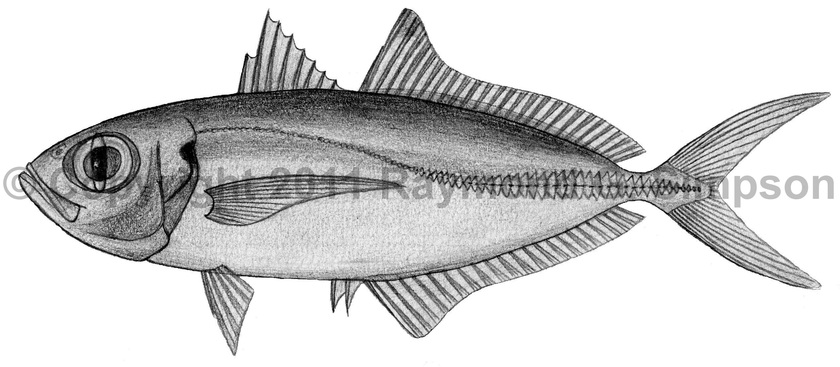
Common Name
Bigeye Scad
Year Described
Bloch, 1793
Identification
Dorsal Fin: 8 spines, followed by I, 24-27
Anal Fin: 2 spines (resorbed in large fish), followed by I, 21-23
Pelvic Fin: I, 5
Gill Rakers: 9-12 upper, 27-31 lower; 37-42 total
Vertebrae: 10 precaudal, 14 caudal
Elongate and ovoid, with a large head and eye. Adipose eyelid well developed, covering entire eye except for a small slit over pupil. Jaw extends to anterior margin of eye. Teeth in a single row in both jaws. Shoulder girdle margin with a deep furrow, and a large papillae above the furrow and another smaller papillae at upper edge. Pectoral fins shorter than head. Spiny dorsal fin about as high as the anterior lobe of the second dorsal. Anterior lobe of anal fin also raised. Tail deeply forked. Dorsal accessory lateral line extends rearward to below first dorsal fin. Main lateral line with curved anterior portion (with 28-56 scales and 0-4 scutes) and a straight posterior portion (with 0-4 scales and 29-42 scutes); totalling 83-94 scales/scutes. Small cycloid scales on entire body except behind pectoral fin.
Color
Blue to green above grading to silvery or white below and on the sides. Snout dusky to black. A yellow lateral stripe is often present. A dark spot is present on the upper opercular margin. First dorsal fin clear with a dark margin. Second dorsal fin and caudal fin dusky with dark tips to the fin lobes. Anal fin clear with a dusky base. Pectoral fin yellowish.
Size
Common to 24cm. Maximum size to 27cm.
Habitat
Shallow coastal waters over reefs, soft bottoms, and in the surf zone. Forms large schools.
Range
Nova Scotia to Brazil, including Bermuda and the Caribbean islands.
References
Smith-Vaniz, W.F. 2003. Carangidae (pp 1426-1468). In: Carpenter. 2003. The living marine resources of the Western Central Atlantic v. 3.